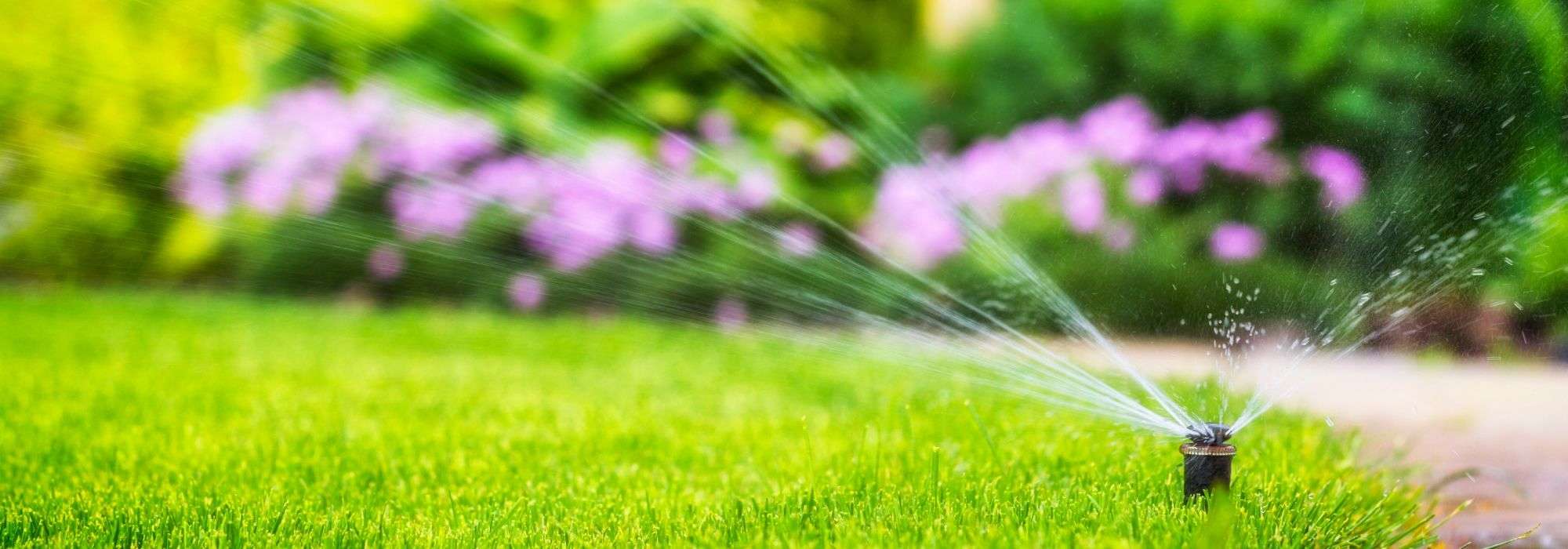
Automatic watering: different systems, which one to choose?
All our advice to help you make the right choice
Summary
Watering is one of the essential tasks to keep plants in top condition and ensure generous flowering in summer.
Whether it’s the short grass meadow, flower beds or bushes, hedges, plants grown in pots on a balcony or even the vegetable garden, installing an automatic irrigation system frees the gardener and allows water savings of up to 70%. From single cones to integrated irrigation, via sprinkler irrigation or drip irrigation, each system ensures regular irrigation, especially when connected to a timer, and prevents your plants from ever suffering from drought, even when you’re away on holiday. Discover different options so your garden never runs short of water and our tips to help you make the right choice!
Also discover our advice for installing an automatic irrigation system on a balcony or terrace.
Various automatic irrigation systems
Sprinkler irrigation
Whether oscillating, circular or semi-circular, cannon-type, impact, on tripod, on sled or on spike, sprinklers (sometimes called ‘sprinklers’) allow irrigation of large areas, much like a natural rain.
They are suitable for watering short grass meadows, but as water becomes an increasingly precious resource, I recommend letting nature take its course. If rainfall is sufficient, all the better! If your lawn yellows in mid-summer, it is not disastrous. With first autumn rains it will green up again. Each year, watering restrictions are regularly imposed and further limit scope for manoeuvre. For more information, read our article: Water and watering restrictions: how to manage them?
This irrigation system can also be used for beds of bushes and perennials, but it has the double drawback of wetting foliage (some plants dislike this and may develop diseases) and of not targeting individual plants. Not all plants have same needs, and weeds in particular grow even more if watered. It is also necessary to have several sprinklers or to move them to cover larger areas.
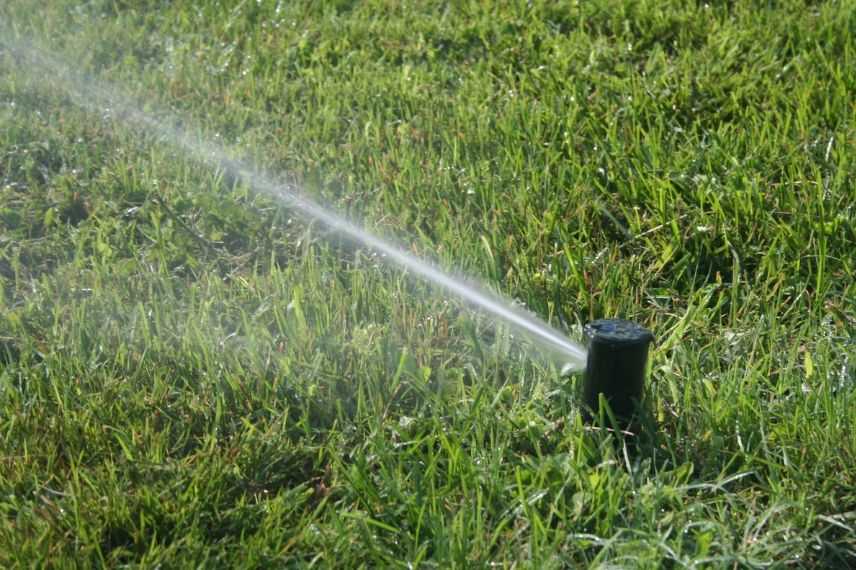
Prefer instead systems that are more water-efficient and more precise.
Micro-sprinkler irrigation
Principle is similar to previous, but micro-sprinkler irrigation is more targeted. A main network starts at supply source (tap for example) and divides into secondary networks, each fitted with a micro-sprinkler, often mounted on a stake pushed into soil. A fine spray is thus delivered at low pressure and can water large beds. Adjustable (flow, spray radius), this system delivers a quantity of water better suited and more targeted, but again all plants are watered from above (including weeds), and plants must be able to tolerate this without health risk. Sprinkler irrigation has some advantages. Installation is straightforward and requires only a limited number of parts to assemble. Sprinklers, positioned above ground, are also not soiled by soil. Moving the various sprinklers is easy to carry out. Use of simple or ‘T’ fittings allows creation of a network adapted to configuration of area concerned.
Drip irrigation
A main network, made up of a polyethylene pipe of varying rigidity, is laid out on soil. Along it, smaller-diameter flexible tubes are connected and linked to drippers (various types exist). Each dripper is positioned at base of plant to be watered, and adjustable flow allows right amount according to plant.
Also operating at low pressure, drip irrigation provides very targeted watering and is easy to implement. Ready-to-fit kits are even available. Highly adaptable, drip irrigation requires as many individual drippers as there are plants to water, but it avoids contact between water and foliage and thus limits development of certain diseases, such as late blight on tomatoes or marssonina on roses.
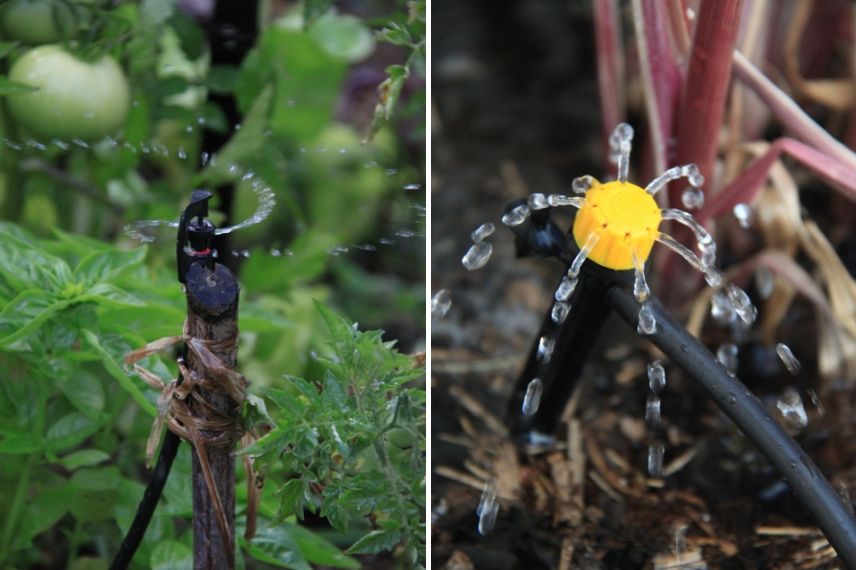
Micro-porous irrigation
This involves using a flexible hose fitted with ‘pores’ that allow water to seep slowly along its entire length. Inexpensive, it is particularly easy to implement because it requires no assembly. Simply unroll hose in straight lines or snake it between plants. This system can work when connected to a water reserve positioned at height to create sufficient pressure. However, hose, in direct contact with soil, can easily become clogged. Flow is sometimes irregular between start and end of circuit, and adding branches worsens this problem. Amount of water delivered is hard to assess and cannot be adjusted to specific needs of each plant. Finally, over time these micro-perforated hoses can become brittle.
Integrated (or buried) irrigation
This irrigation system is certainly most discreet but also most difficult to implement. Burying pipes requires digging trenches which, once in place, prevent any movement or new planting in affected areas. Sprinklers rise from soil under pressure, water your lawn or plantings, then retract once cycle is complete. Addition of pumps is necessary if pressure is insufficient, and any fault in circuit requires inconvenient interventions. Cost of this irrigation system is higher than previous options and is justified for large areas.
You may also read
Watering the garden: how to do it?Choosing the right automatic irrigation system for your garden
Choose an irrigation system suited to the intended use. Here are some pointers to help you make your selection.
- Short grass meadows: for small areas (under 50 or 100 m²), opt for a sprinkler system. If you have a very large short grass meadow, investing in an in-ground network can prove cost-effective.
- Hedges, vegetable gardens and row plantings: micro-porous hose and micro-spray systems work well for this use. Some plants require keeping foliage dry, which makes using drip irrigation the wiser choice. Discover our tips for How to water the vegetable garden in summer.
- Beds and borders: sprinkler irrigation, micro-spray and drip irrigation, as well as using a micro-perforated hose can be suitable. Choose according to area, plants’ ability to withstand foliage watering or ease of installation.
- Plants in pots on balconies and terraces: all sprinkler or micro-porous irrigation should be avoided. Opt for drip irrigation, assigning one or several emitters per pot (depending on size and number of plants), and adjust flow rate according to needs of each plant. For more information, read our article Potted plants and watering: coping with hot weather during your absence.
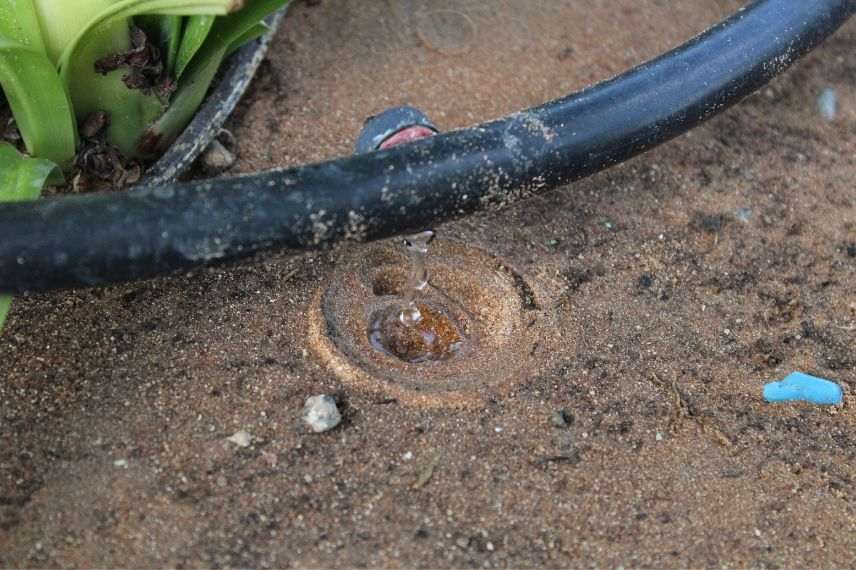
Automatic watering, alternatives and tips
While automatic irrigation systems are convenient and economical, it is not always possible or desirable to install them. Fortunately, alternatives exist. They can help free you a little from the chore of watering or prevent your plants and garden from suffering too much during your absences.
- Porous ceramic cones, also called irrigation spikes or watering spikes, are very simple to use. They can be screwed onto a water bottle (1.5 litres or more) which is turned upside down and pushed into the soil. It is also possible to connect them, via thin tubes, to a water reservoir (covered to limit evaporation and insect colonisation) placed at height. The autonomy of such a system depends, of course, on volume of water available and is better suited to plants in pots on a balcony.
- For young trees (planted individually or in an orchard, for example), consider using oyas. These terracotta jars, in various sizes, are buried at the base of the plants. Simply fill them with water and let it filter through their porous material to the roots. Just remember to check water level from time to time.
- For the most water-hungry plants, place a saucer under pots or mix into planting soil a water-retaining product such as Stockosorb. These products absorb water at each watering and release it according to plant’s needs.
- Some irrigation kits include a pump to place in a simple water reservoir. Solar-powered, it can therefore be installed anywhere in the garden.
Automatic, modular and adaptable watering systems
Many watering systems operate with a timer, powered by solar energy or a battery. This allows you to select what time, how often and for how long to water. In any case, prefer early morning or late evening. Some can be connected to a moisture probe which, depending on weather, activates or not a watering session. Some versions can even be controlled from a tablet or mobile phone.
Timers can be coupled with a filter to reduce risk of sprinklers becoming clogged by impurities.
Equipped with a liquid-fertiliser dispenser, they provide regular feeding for the hungriest plants.
Often operating at low pressure, a pressure reducer must be installed at the start of the system.
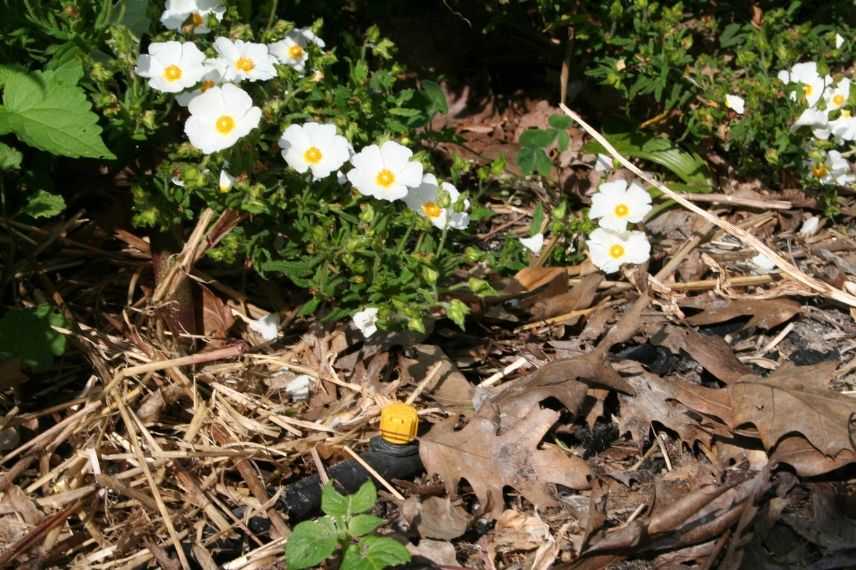
Maintenance and winterising of automatic irrigation systems
In winter, your plants no longer need assisted watering. Natural rainfall meets their needs.
Your irrigation system must be cleaned and removed to prevent it being damaged or breaking due to frost.
Here’s what to do before the cold sets in :
- Drain your system. Turn off the water supply at the source and open the purge or stop valves located at the end of the network to drain water from the pipes.
- Remove drippers or sprinklers and soak them in a mixture of equal parts lukewarm water and vinegar, to clean off limescale that has built up during the season. Rinse them afterwards with clean water.
- Unscrew the controller, drain any water from it and remove the batteries.
- Coil the hoses without kinking them.
- Store your equipment in a frost-free location.
- Subscribe!
- Contents
































Feedbacks